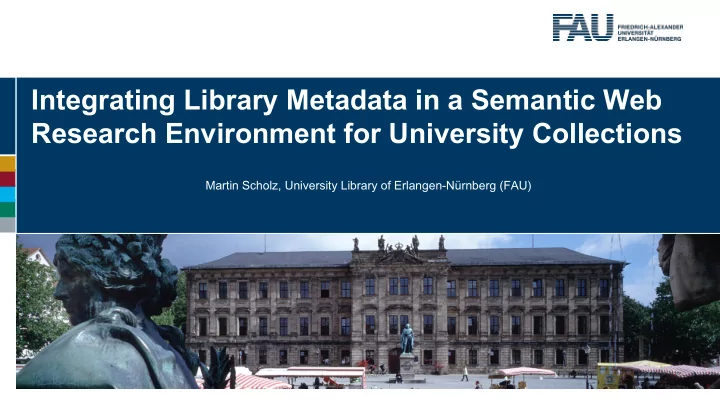

Integrating Library Metadata in a Semantic Web Research Environment for University Collections Martin Scholz, University Library of Erlangen-Nürnberg (FAU)
University & academic collections ● > 1000 collections in Germany ● very heterogeneous material, conditions & documentation ● ~ 60% not digitally accessible ● ~ 40% with high-quality digital image https://portal.wissenschaftliche-sammlungen.de/kennzahlen, CC-BY-NC 3.0 Martin Scholz: Integrating Library Metadata in a Semantic Web Research Environment for University Collections 27.11.2018 2
Collections at the University of Erlangen-Nürnberg ● > 20 collections ● heterogeneous material, size, condition and documentation ● scattered (historically and administratively) ⇒ till now no common presentation ⇒ central custodial agency ⇒ digitization strategy https://www.fau.de/universitaet/das-ist-die-fau/sammlungen-der-fau/ Martin Scholz: Integrating Library Metadata in a Semantic Web Research Environment for University Collections 27.11.2018 3
The project “Objekte im Netz” (2017-2020) Goals: Common standards for (digital) documentation ➢ Best practices, guidelines & tools ➢ Means: 6 pilot collections: graphics , medicin history, mineralogy, music, ➢ prehistoric archaeology, school history ➢ WissKI as common indexing and research tool CIDOC CRM as common data model ➢ http://objekte-im-netz.fau.de Martin Scholz: Integrating Library Metadata in a Semantic Web Research Environment for University Collections 27.11.2018 4
(Wissenschaftliche KommunikationsInfrastruktur) virtual research environment for cultural heritage documentation ➢ for complex, network-like data ➢ ➢ data stored natively as CIDOC CRM / OWL wiki-like aggregation of information ➢ XAMP - Drupal - WissKI ➢ http://wiss-ki.eu Martin Scholz: Integrating Library Metadata in a Semantic Web Research Environment for University Collections 27.11.2018 5
WissKI approach: ontology paths Backend: Data stored as RDF triples ➢ Local & external sources ➢ Frontend: Aggregated view ➢ Mixed media (tabular, textual, ➢ image, …) http://www.patrimonium.net Martin Scholz: Integrating Library Metadata in a Semantic Web Research Environment for University Collections 27.11.2018 6
WissKI approach: ontology paths Photo → R26 documents → Path patterns are used to aggregate Hindenburg Hindenburg → information from the triple data P131 is identified by → Name Name → P3 has note → „Paul von Hindenburg“ http://www.patrimonium.net Martin Scholz: Integrating Library Metadata in a Semantic Web Research Environment for University Collections 27.11.2018 7
Collection model Common top ontology based on CIDOC CRM Domain ontologies for collection specifics Class “Collection object” as main entry point Martin Scholz: Integrating Library Metadata in a Semantic Web Research Environment for University Collections 27.11.2018 8
The graphics and prints collection Small but renowned collection: paintings, graphics, prints, maps, … ~5000 prints, thereof: 2162 are catalogued according to bibliographic rules and available online 12 digitized images available Sisis / local ⇒ item information Aleph / library network ⇒ expression / work information Martin Scholz: Integrating Library Metadata in a Semantic Web Research Environment for University Collections 27.11.2018 9
Graphics Collection as part of Objekte im Netz case study: how to integrate bibliographic metadata into the collection model / database? piloting with ~2000 prints data accessible via OAI-PMH + SRU in MARCxml Albrecht Altdorfer: Das Urteil des Paris, 1511, Signatur: H62/AH 13 Martin Scholz: Integrating Library Metadata in a Semantic Web Research Environment for University Collections 27.11.2018 10
Data integration workflow (first approach) 1. fetch data from OAI-PMH and SRU on demand ⇒ MARCxml records 2. convert MARCxml to BibFrame with marc2bibframe2 (xslt scripts) ⇒ RDF triples 3. provide (rudimentary) LOD-REST-API 4. align BibFrame with CIDOC CRM (with help of FRBRoo): ⇒ build congruent ontology paths 5. integrate library data as external “authority” ⇒ authority data dynamically enriches local WissKI data “correct & neat” from LOD perspective Martin Scholz: Integrating Library Metadata in a Semantic Web Research Environment for University Collections 27.11.2018 11
Data integration workflow (current approach) 1. periodically fetch data from OAI-PMH and SRU ⇒ MARCxml records 2. store records in SQL table 3. convert MARCxml to CIDOC CRM using WissKI SQL Import feature ⇒ build triples directly according to local model & mapping file 4. import library data into local WissKI data ⇒ library data becomes part of local data and is periodically updated “quick & dirty” from LOD perspective Martin Scholz: Integrating Library Metadata in a Semantic Web Research Environment for University Collections 27.11.2018 12
WissKI SQL Import Martin Scholz: Integrating Library Metadata in a Semantic Web Research Environment for University Collections 27.11.2018 13
Why not first approach? Mainly practical issues… Incomplete / incorrect / inconvenient conversion to BibFrame ⇒ special fields, deviating semantics; blank nodes Ontological “mismatches” between BibFrame and CIDOC CRM ⇒ BibFrame is less verbose ⇒ missing intermediate nodes / resources ⇒ virtual mismatches due to conversion Fetch-on-demand or import / Authority data or local data ⇒ affects performance and search Martin Scholz: Integrating Library Metadata in a Semantic Web Research Environment for University Collections 27.11.2018 14
Further observations Technical hindrances: half-conforming APIs for OAI-PMH and SRU client libraries (e.g. phpoaipmh) fail Missing URIs: no officially coined URIs for items or expressions by library network ⇒ own URIs (as with other collections) Unique objects vs. serial production / item vs. work ⇒ other collection domains don’t apply FRBR concepts ⇒ divergent models BibFrame is used in the background to evaluate the local modelling / mapping Martin Scholz: Integrating Library Metadata in a Semantic Web Research Environment for University Collections 27.11.2018 15
Thank you! Martin Scholz: Integrating Library Metadata in a Semantic Web Research Environment for University Collections 27.11.2018 16
Recommend
More recommend